Embibe Experts Solutions for Chapter: Matter and Magnetism, Exercise 2: Exercise-2
Embibe Experts Physics Solutions for Exercise - Embibe Experts Solutions for Chapter: Matter and Magnetism, Exercise 2: Exercise-2
Attempt the practice questions on Chapter 26: Matter and Magnetism, Exercise 2: Exercise-2 with hints and solutions to strengthen your understanding. Alpha Question Bank for Medical: Physics solutions are prepared by Experienced Embibe Experts.
Questions from Embibe Experts Solutions for Chapter: Matter and Magnetism, Exercise 2: Exercise-2 with Hints & Solutions
A bar magnet having a magnetic moment of is free to rotate in a horizontal plane. A horizontal magnetic field exists in the space. The work done in taking the magnet slowly from a direction parallel to the field to a direction from the field is
Two identical bar magnets are fixed with their centres at a distance apart. A stationary charge is placed at in between the gap of the two magnets at a distance form the center as shown in the figure
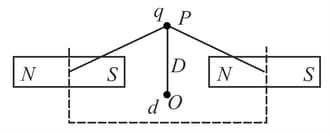
The force on the charge is
There are four light-weight-rod samples, separately suspended by threads. A bar magnet is slowly brought near each sample and the following observations are noted.
i. is feebly repelled.
ii. is feebly attracted.
iii. is strongly attracted.
iv. remains unaffected.
Which one of the following is true?
A short bar magnet of magnetic moment is placed in a uniform magnetic field of . The magnet is stable equilibrium when the potential energy is:
Following figures show the arrangement of bar magnets in different configurations. Each magnet has magnetic dipole . Which configuration has highest net magnetic dipole moment?
(a) (b)
(b) (C)
(C)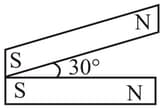 (d)
(d)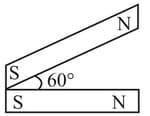
At a point on the earth's surface of angle of dip, At a point on the earth's surface the angle of dip, We can interpret that:
The coercivity of a small magnet where the ferromagnet gets demagnetized is The current required to be passed in a solenoid of length and number of turns so that the magnetic gets demagnetized when inside the solenoid, is___
Hysteresis loops for two magnetic materials and are given below:
(A)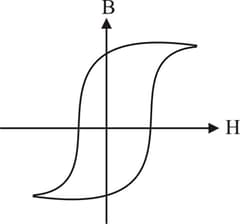 (B)
(B)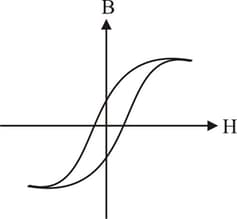
These materials are used to make magnets for electric generators, transformer cores and electromagnet cores. Then it is proper to use
